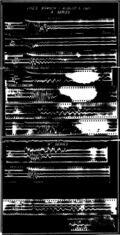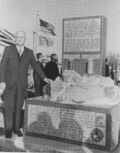John Karcher
John Clarence Karcher (June 4, 1894 - July 13, 1978) was an American geophysicist and businessman. He invented and eventually commercialized the reflection seismograph, applying for patents on this in 1919. In doing this he created the means by which most of the world's oil reserves have been discovered. In 1930 he and Eugene McDermott founded Geophysical Service Incorporated, a pioneering provider of reflection seismology services to the petroleum industry.[1] This company later spun off what would become Texas Instruments.
Biography
Early life
John Clarence Karcher was born on April 15, 1894 in Dale, Indiana. He was the son of Leo and Mary (Madlon) Karcher. When he was five the family moved to Oklahoma Territory and settled in a farming community near Hennessey. In 1912 he earned a high school diploma.
Education
As an undergraduate Karcher attended the University of Oklahoma where in 1916 he received a Bachelor of Science degree in both Electrical Engineering and physics and was at the head of his class. When the university was granted a chapter in 1918, he was elected to Phi Beta Kappa. Upon graduation Karcher accepted the Tyndal Fellowship in Physics at the University of Pennsylvania where he began graduate work in September 1916. For his Ph.D. thesis he studied X-ray emissions. World War I interrupted his graduate studies and he served with the United States Bureau of Standards. His assignment was to locate heavy artillery batteries in France by studying acoustic waves the guns generated in the air. He noted an unexpected event in his research and switched his concentration to seismic waves in the earth. He thought it would be possible to determine the depth of underlying geological strata by vibrating the Earth's surface while precisely recording and timing the returning waves of energy.
On October 16, 1920, Karcher married Lydia Kilborn; they had two children.
Career
In 1919 Karcher applied for patents in reflection seismography. In 1921 this technology was proven as a valid method in the search for oil (the Vine Creek experiment) but at the time oil prices were such there was no demand for this new technology. Karcher first went to work for the Bureau of Standards, and then joined Western Electric Company where he performed research on ocean-bottom telegraph cable. It was here that he first met a young Eugene McDermott.
The Vine Creek reflection seismic experiment
- Dr. D. W. Ohern, geologist, and Dr. W. P. Haseman, physicist, two of Karcher's former professors at OU, collaborated with him in refining the seismograph's design. Hoping for a successful commercial use of the device by the petroleum industry, the men formed Geological Engineering : Company and prepared to conduct a test.
- Karcher, Ohern, and Haseman were joined by Dr. Irving Perrine, also an OU geology professor, and geologist William C. Kite in readying the instrument and finding a suitable site. Financial backing was provided by Oklahoma City oilmen Frank Buttram and brothers Walter R. and William E. Ramsey.
- On June 4, 1921, on a farm three miles north of Oklahoma City (now at the site of the Belle Isle Library, Northwest Expressway and Villa), the team tested the seismograph and determined that it could, indeed, show subsurface structure that was capable of holding oil. [2]
Later when Everette Lee DeGolyer, vice president and general manager of Amerada Petroleum Corporation of Dallas,[3][4] learned of Karcher's 1921 experiments with the seismograph he held a meeting with Karcher that resulted in the creation of Geophysical Research Corporation (GRC) of Tulsa. This was as a subsidiary of Amerada.
Karcher was made vice president, given a $300,000 research fund and given a 15 percent stock interest. One of his first actions after establishing headquarters in Bloomfield, New Jersey, was to hire Eugene B. McDermott, his protégé from Western Electric, then a Columbia University graduate student. GRC introduced the seismic reflection method which over the next five years was accepted by the petroleum industry as a promising new tool. In 1930, with the backing of DeGolyer, now president of Amerada, Karcher and McDermott launched Geophysical Service Incorporated, which was later sold and renamed as Texas Instruments. Karcher served as president and McDermott as vice-president.[5]
Legacy
On June 4, 1971, the Geophysical Society of Oklahoma City erected a monument stating that at this site they "proved the validity of the reflection seismograph as a useful tool in the search for oil."[6] To commemorate the fiftieth anniversary of the first reflection seismic oil exploration test, a granite monument was erected at the site of this test. At this site, currently in Oklahoma City in the front lawn of Belle Isle Library, in 1921 Karcher and his team recorded their first seismic data.
While J. C. Karcher is given credit for designing and conducting the first reflection seismic experiment for petroleum exploration, he was not alone. His four associates where Dr. D.W. Ohern, Dr. Irving Perrine, Dr. William P. Haseman, and William C. Kite[7]. Important contributions to the initial development of the reflection seismic method were made by Burton McCollum, and Dr. E. A. Eckhardt, and their work was based on technology developed by Reginald Fessenden.
References
- ↑ The Handbook of Texas Online, Retrieved Sep 20, 2008
- ↑ Oklahoma History Center http://www.okhistory.org/publications/enc/entry.php?entry=SE008
- ↑ The History of DeGolyer and MacNaughton
- ↑ The Handbook of Texas Online - DeGolyer, Everette Lee
- ↑ Wishart, David J. "Encyclopedia of the Great Plains", via Google Books. Accessed September 22, 2008.
- ↑ Oklahoma City Geophysical Society Retrieved Oct 23, 2008
- ↑ Eby, J. .B (1974) My two roads, Pacesetter Press, Houston, p. 97.
External links
- Schriever, W. (1952). ”Reflection seismograph prospecting - how it started.” GEOPHYSICS, 17(4), 936–942. http://dx.doi.org/10.1190/1.1437831
- Karcher's reflection seismic patent.
- Karcher's Red Book - observer notes from June-Aug, 1921
- Karcher's Black Book - miscellaneous notes from 1925-1930



